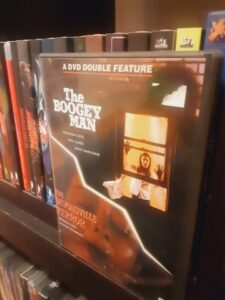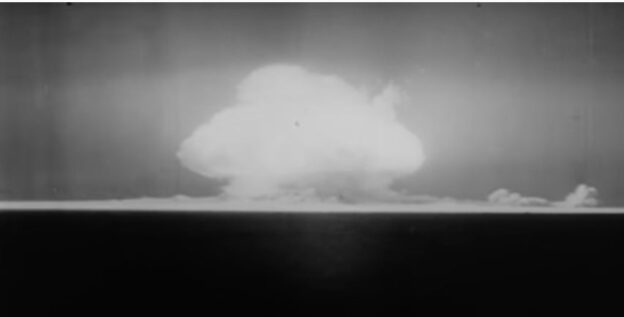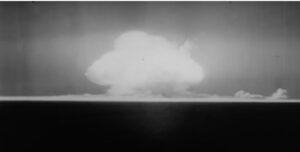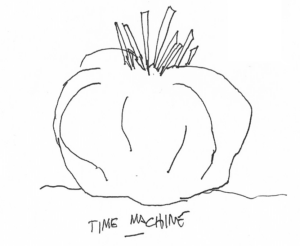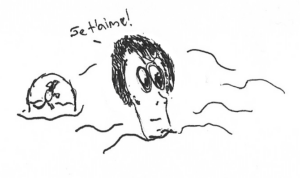It wasn’t completely by chance that my movie viewing began heading down an apocalyptic path when current events started getting serious. Some people, it seems, escape into meme-ready comfort TV, and others stare hard into the abyss with rigorously dismal cinema. I’m generally one of the latter types, and so it seemed to make sense to write about what I’ve been watching and I guess, maybe, to try to figure out why I’m putting myself through this. While I haven’t been watching any of the more directly topical blockbusters like Contagion or 12 Monkeys (though believe me, I think the latter movie’s a scorcher — the first I don’t remember well), I think that the best of the movies I’ve been watching – or even the less good ones – reflect our reactions to fear, uncertainty, tragedy, and utter lack of control in ways that, if they’re not necessarily easy to watch, can be valuable to think about. And the worst — at least one has a bootleg Terminator in it, but is nevertheless thought-provoking in its way.
While I had intended to do this as one post, I’m going to split it out into a couple as these reviews have run a bit long. What can I say, I over-write when I get antsy. Spoilers are to be found throughout, if you care about that sort of thing. Anyway, speaking of figures not known for their brevity…
The Turin Horse (2011) Dir. Béla Tarr
It seemed like a no-brainer, with the official onset of a global quarantine, to reach for whatever movie I could find by the most canonically morose living director in world cinema – Hungary’s Béla Tarr. I found The Turin Horse streaming, its relatively slim 2.5 hours marking the intentional end of Tarr’s filmmaking career and depicting, perhaps not coincidentally, the on-screen end of the world.
The film derives its name from an anecdote about the latter-day life of Friedrich Nietzsche. The philosopher, traveling through Italy, reputedly saw a man beating a horse. Nietzsche threw himself on the horse to protect it, weeping. Taken home, he then uttered his last sane words: “Mutter, ich bin dumm” (“Mother, I am dumb”). This anecdote – retold at the beginning of Tarr’s film – is as oft-shared among readers of philosophy as the one about Kant’s precisely-timed daily walks through Königsberg, Jeremy Bentham’s practical-to-a-fault mummification, and those tales of any number of philosophers’ masturbatory habits each as unique as a snowflake.
Scholars point out, however, that The Turin Horse story is apocryphal – it’s a bit too close to a fictional anecdote found in Dostoevsky’s Crime and Punishment, and there is little historical evidence to corroborate that it happened.

The closest thing to a picture of The Turin Horse I could find to accompany this review.
It’s not hard to get why we keep telling it, though (or naming movies after it): Nietzsche was a man who saw atheism as an inescapable reaction to the modern world being demystified through science and reason, a world which now posed questions without viable answers, leaving those perceptive enough to appreciate the situation nothing but despair to grapple with. He believed that our most basic moral intuitions and social norms were false, and that to recognize them as such was to be set above those who believed, unquestioningly, in their universality. He was a philosopher preoccupied with the hideous anguish and, potentially, sublime beauty of an existence devoid of transcendence. In one final gesture of unmatched sensitivity, he collapsed at the tragedy of it all and never again spoke a word. (Nietzsche did, in fact remain sitting in a chair in complete silence for the final 10 years of his life). Whether or not it happened, the story seems to act as a capstone on the bleak, poetic irrationalism of his thought. To quote actor Gunnar Björnstrand, speaking to film critic Peter Cowie at the first screening of Ingmar Bergman’s The Silence: “Pretty strong stuff, isn’t it?”
The stuff of Tarr’s final film is unfortunately not quite that strong. At the beginning, the haunting voice of the film’s occasional narrator recounts the final equine encounter of Nietzsche’s sane existence, then assures us that “of the horse, we know nothing.” We then see a horse, being driven by a rustic farmer against the backdrop of a landscape with an unyielding wind blowing (it doesn’t let up through the duration of the film). We wonder if maybe we’re watching a piece of philosophical fan-fic fleshing out the story of a semi-mythical bit player. It’s been done to excellent effect before, in literature (Pär Lagerkvist’s Barabbas) and film (Tom Stoppard’s Rozencrantz and Guildenstern Are Dead). It seems as though we’re being set up to see this great historical victim of abuse, having been saved by a philosophical titan, going on to live out the rest of its life like the donkey in au hazard Balthazaar; a picture of innocence in a wretched world.
In fact it’s not exactly clear if this is The Turin Horse we’re dealing with or merely a horse of a similar color. We see the horse occasionally throughout the movie, but most of the film is focused on the farmer and his daughter, living inside a small, sparse cabin. Day after day, the father wakes up in his long johns and the daughter mechanically dresses him. They saddle and unsaddle the horse. They do shots of brandy. She boils two potatoes and serves them each one. Everything they do, especially how they eat, has a ritualistic feel – the father scratches the skin off of his potato with one hand, smashes it and picks it apart, the daughter peels hers fastidiously with both hands. The characters gobble their respective potatoes while they are still steaming. The wind outside gets stronger.
“Of the horse, we know nothing.”
While Wikipedia pegs this movie as taking place in the 19th century (due presumably to the transportation, style of heating, living arrangements, etc.) it’s details like this almost alien mode of potato consumption that make me think the movie, in fact, takes place in a sort of timeless semi-reality – along the lines of the fabulistic nowhere of Kafka’s The Castle. (I suppose it’s possible that it could be a super specific cultural practice, but I can’t see Hungarian farmers of any era willfully burning the hell out of their mouths with every potato). This sense is bolstered by the fact that, as the wind continues to howl, the farmer and his daughter have only two encounters with other humans. In the first, a man shows up looking for brandy and explains to the farmer that the village no longer exists. The farmer appears unrattled. In the second, a bawdy dance macabre of gypsies show up attempting to spirit the daughter away; the father chases them off with an axe. The father and daughter are entirely unmoved from their routine despite evidence filtering down from all quarters that something big is happening. The horse, meanwhile, seems like a bellwether for the impending apocalypse – refusing to eat and otherwise acting out as the situation outside degenerates.
On the final day, things change. They try to leave; it’s not wholly clear if they succeed and arrive in an identical cabin, or just return home. We see characteristically long, somber shots of the daughter staring out the window. The two try to light a lamp. It doesn’t work. Entropy, it seems, is signaling a victory. Fire no longer works, it slowly flickers out. In some of the movie’s most haunting scenes – confined to the last few minutes – only the howl of the wind is audible and the film cuts to absolute darkness.
I’ve been putting a lot of thought into what the circumstances of the characters in this esoteric fable might mean. If we’re indeed seeing the abuser of the semi-historical Turin Horse cursed, as a stand-in for all banal tyrants, to remain in some loop of eternal reccurence, unwilling or unable to vary even minutely as things decay around him. Or if it’s a more broad meditation on our tendency to throw ourselves into ritual or keep our heads down and hope for the best, even as we’re watching things break down around us. Worthwhile topics for an art film of this type to explore, but I wish the movie would have been overall stronger.
Which is to say that despite those captivating, long-running shots synonymous with the name Béla Tarr movie, a minimal plot made for philosophizing, and the ending’s staggering collapse into black (which is excellent), I don’t think this one touches his masterpiece, Werckmeister Harmonies. That one makes me sob like a baby every time I watch it, no exaggeration – it’s up there with Tokyo Story in terms of movies that can provoke such a reaction. I think it’s precisely because in Werckmeister – in addition to the film’s formal beauty — amid the ominous and Kafkaesque imagery, it’s about a search for transcendence. From the opening scene, Werckmeister grapples with hope in its cryptic, mystical way, whereas The Turin Horse ignores its possibility outright. I think in some ways the former approach is both more affecting and sadder.
Even the score in The Turin Horse pales in comparison to Werckmeister; in Werckmeister, there’s a somberness and longing in composer Mihály Víg’s Badalamenti-meets-Philip Glass-style score that matches that of the characters. In The Turin Horse it leans too heavily on the Glass side, as repetitive as the characters’ existences, but not as powerful as their circumstances demand. This was an OK way for the world to end, but it wasn’t quite what I’d hoped for as the final statement from a talent as singular and significant as Tarr.
Shocking Dark AKA Terminator 2 (1989) Dir. Bruno Mattei 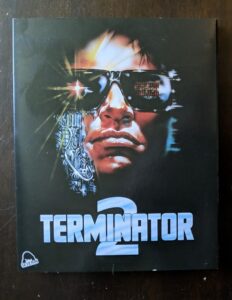
Right, so after all that going on about how I was watching movies about life and death (and mostly death), I’m writing up a schlockfest I’ve been meaning to write about for a minute that just so happens to be, at least marginally, an apocalypse thriller. It’s so much more, though. The release of Shocking Dark from Severin Films was one of the biggest deals of 2018 for Blu-ray collectors and it’s hard to think of a curio coming out from any distributor that has matched it since. The 1989 Bruno Mattei-directed, Claudio Fragasso/Rossella Drudi-penned film owes it’s notoriety to the fact that it is a work of copyright infringement so brazen that it had never gotten a release outside of continental Europe until Severin put it out. Its original release title, Terminator 2, and the accompanying cover/poster artwork, may give you a hint as to the nature of the grift at play that kept it confined to Europe, but this film’s disregard for trademarks is more than just skin deep.
In the movie, an algal bloom or toxic cloud of some sort has rendered the Venice of the then-future early-’00s a toxic wasteland. A scientist and maybe some other people have disappeared into the catacombs built underneath the city – apparently to expunge the pollution. The surveillance cameras in the tunnels have stopped working. This leaves the Megaforce Marines, a military team dressed like dollar store action figures, to go on a search and rescue mission accompanied by Sam Fuller of the shadowy Tubular Corporation who just sort of shows up, and Dr. Sara Drumbull, a doctor of something from somewhere. Frequent Bruno Mattei leading lady and Demons star Geretta Geretta plays Koster, who distinguishes herself as the only member of the Marines with a consistent personality throughout the duration of her appearance. She plays it big. Like, R. Lee Ermey big – berating and trading racial barbs with her Italian cohort, going as far as to ask – in one particularly inspired bit of dialogue down in the sewer-like catacombs – what his countrymen eat to “make their shit smell so bad.” (To once again quote Gunnar Björnstrand, “pretty strong stuff, isn’t it?”)
The smell of those catacombs is no human excreta, though. It is the stinky rubber monsters that are eating people, or wrapping them up in spiderwebs, or possibly turning them into other monsters – as is explained in one clunky line of kinda-sorta scientific dialogue – sandwiched in between interminable scenes of walking. Amid a monster attack here and there, the Marines end up finding the lost scientist’s daughter. Her face is affixed in sort of a pained contortion of fear, she whines constantly in an accent of indeterminate origin. She clutches Dr. Trumbull for safety and repeats her name every time anything threatening happens. So much so that if you watched this movie intending to drink every time a character said the name “Sara,” you would die of alcohol poisoning within a matter a minutes. At some point along the way we discover that Sam Fuller from the Tubular Corporation is actually an android, and the Tubular Corporation is, in fact, the samesuch corporate entity that destroyed the environment in the first place, intentionally, as part of an unnecessarily convoluted real estate scam.
The kicker, though, is an introduction of a conveniently and inexplicably-placed time travel pod left by The Tubular Corporation, allowing Dr. Trumbull and her Sara-screaming sidekick to return to the pre-enviropocalyptic past. They warp back and are followed by android Sam Fuller, who lands in c. 2000 AD and stomps on a remote controlled car in a shout-out to the officially licensed Terminator. He then has half of his face blown off, to mimic the look of the officially licensed Terminator as much as one could possibly manage with no budget, barely any time, and a limited amount of skill. Just as the action leading up to it is basicaly a knockoff of Alien made within the same parameters. Which I think is the beauty of an artifact like this.
I remember seeing an interview about 10 years ago with Luigi Montefiori AKA George Eastman, star of Anthropophagus and a few million other Italian genre films. He said that the Italian sci-fi movies of the era, unlike the horror movies, never really developed their own style because they were always knock-offs of U.S. movies. The more I see of these the more inaccurate that strikes me. This movie, Rats, and 2019, After the Fall of New York, are all way more similar to each other than they are to the contemporaneous U.S. science fiction films they intended to knock off. Watching these movies is almost like seeing the profitable elements of U.S. genre films filtered through a Five Obstructions-esque series of constraints. Concerns over intellectual property rights, of course, not being one of them — quite the opposite. It wasn’t a matter of needing to be original, but finding an original way to be unoriginal.
Which is why this movie got me thinking what’s so exciting about seeing unauthorized, international takes on familiar properties like this. When something like this gets rediscovered it’s always a surefire hit, take for example the wave of interest in Turkish Star Wars probably about 15 years ago. It doesn’t even have to be fully bootleg. Even in cases where a contract was actually brokered, like with the Japanese TV series that casts Spider-Man as an alien who operates a giant Voltron-style kaiju robot (has that gotten a proper stateside release yet?) there’s a sort of surreal sense of disbelief seeing such familiar characters used in weird, unfamiliar ways. The same reason we’re drawn to bootleg action figures and knock-off Simpsons gear. It’s endlessly fascinating to see the way people can get things kind of right while getting them completely wrong.
In a strange way, though, I think the impact of a movie like Shocking Dark has been blunted by the current technological moment. Advances in home digital filmmaking let basically anyone do their own lo-fi takes or mashups on whatever licensed property they please. My first time through Shocking Dark, I kept trying to think of it as I would have had I come across it 20 years ago. I couldn’t quite be as flabbergasted as I wanted to. Today, I can visit Vimeo and watch a pretty dead-on fan-fic “remake” of Robocop where the scene in which Robocop saves a woman by shooting her assailant in the crotch expands, or degenerates, into three minutes of Robocop shooting off the dicks of an advancing army of hoodlums. We see less labor-intensive labors of love like this all the time; Force Ghosts of pro-wrestlers cut into Star Wars and whatnot. The only recent thing I can think of that sets off my brain’s disbelief centers anymore is the re-shot Return of the Jedi ending featuring the real-life David Prowse under the Darth Vader mask, discussed in the documentary I Am Your Father, which is presumably hidden in an underground bunker to prevent Lucasfilm/Disney from eradicating it. Nothing else seems quite as shocking, and so Shocking Dark doesn’t watch quite like it would have.

It’s still pretty wild, though. A film that was so sketchy its release had to be constrained to a continent where the film’s language wasn’t primarily spoken isn’t something you encounter every day. Severin did its usual great job of enhancing the Blu-Ray experience with add-on swag, in the form of a limited edition slipcase baring the bootleg Terminator 2 graphics from the original release. At the time the time the Blu-Ray came out, the story was that they would continue to sell until a studio hit them with a C&D. I don’t think it happened as movie studios, litigious as they remain, are probably a little too hip to the Streisand Effect to get goaded into sending a nastygram to a boutique indie outfit. It was a cool stunt though. The disc looks cool on the shelf, and if I ever have guests over — which is a rarity these days — I hope that they’ll be so distracted trying to figure out what the hell it is that they won’t even notice the more tasteless fare that I keep around, like my copy of The Sinful Dwarf, sitting nearby it.
More interesting though are the special features — essential viewing for a movie like this as, if you’ve taken the time to watch it, you’ll doubtlessly want some context for what the hell could have possibly been going on when it was made.
I personally find Claudio Fragasso’s takes on the films he wrote/directed in the era to be fascinating in general. His own rather ambivalent if not slightly tortured relationship with these movies gives a view into the contorted relationship between creativity and commerce, something I’ll get into more if I ever review Zombie 4: After Death. In the Shocking Dark interview with him and Drudi we get, expectedly, kind of a rundown of who knew what and how much when this hot slice of willful deception was being cooked up. Most of the responsibility for the borrowed Terminator is placed firmly in the lap of a duplicitous distributor. But at the very least Bruno Mattei had to know, right, because he was shooting a movie with a Terminator in it and he had to know that he, Bruno Mattei, wasn’t James Cameron? And while Fragasso claims that this one was the first and last flick he ever worked on with such disregard for if not the law in general, at least copyright law, didn’t Severin more recently put out The Night Killer, a Nightmare on Elm Street rip sold in Europe as The Texas Chainsaw Massacre 3? It’s all so weird and confusing and I love it all. I wish I knew how much more of this stuff was actually floating around out there.
The Geretta Geretta interview is likewise fascinating; in detailing her experience making this and other genre movies in Italy, she confirms that there was a lot of heart that went into them. It was a bunch of ex-pat actors doing the hell out of it because they thought any movie they were working on might be the one that broke big — and as outrageous as the final product may have been, I think that’s inspiring.
Going back to the strange, confusing experience of seeing something like this back before the Internet demystified everything, I can’t help but think that somewhere in the U.S., maybe in like Iowa, there must have been a foreign exchange student who showed up at some middle school in 1989, with a story of having seen an as-yet non-existent Terminator 2 with all sorts of weird plot details. For this, s/he was mocked mercilessly. It had to have happened at least once, right? Consider yourself vindicated, kid — who or wherever you are.
Next up …
If you’ve read this far, you’ll be interested to know I’ve got a review of one of my favorite (and now, on re-watch, favoriter) Tarkovsky films in the works, as well as my very favorite George Romero movie. And maybe some others, though honestly I might have to shift gears on my movie viewing to light comedies because I am afraid too much of the type of thing I usually watch is starting to make me flip out.
Anyway, if you dig this, follow me on Facebook or leave some love in the comments and maybe I’ll do these more often. Fiction should be coming out one of these days too … I think. Take care and stay safe.
-M.
